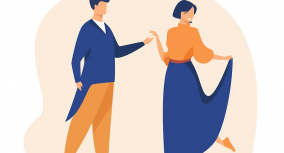The Necklace is one of the most famous short stories that talks about a woman whose dreams of wealth got shattered. The author Guy De Maupassant uses several literary devices, such as metaphors or symbolism, to enhance the reader’s perception.
So, what does the necklace symbolize in The Necklace? What about the mirror? We will find it out in this article!

Necklace
One of the symbolism examples in the story is the necklace that Madame Loisel borrows from Madame Forestier. It symbolizes the idea that looks can be deceiving. The necklace is beautiful and looks expensive. Mathilde cannot even tell the real value of that piece of jewelry. From her perspective, an expensive-looking necklace is the embodiment of social status and class. Mathilde borrows it to appear as someone she’s not. She is confident that an expensive piece of jewelry will bring her closer to a higher society.
Mathilde’s objects of desire are wealth and recognition. In that case, the necklace can undoubtedly represent the wealth in the story—showy but fake. The connection between wealth and appearance can tell a lot. Madame Loisel is not satisfied with the way her apartment or clothes look. The borrowed necklace is elegant, and it gives the perfect opportunity to be the woman she wants, at least for one night. Unfortunately, that’s all it is—a fancy exterior with nothing underneath.
Her friend, Madame Forestier, hides the real value of the necklace. It might be because she doesn’t care about the value of the jewelry. Or because she wants to be perceived as more prosperous than she is. In either case, Mathilde ruins her reasonably comfortable life for a piece of jewelry that isn’t worth it.
Additionally, the necklace symbolizes Mathilde herself. Just as women in the 19th century, it is an accessory. It does not perform any other function except as being visually pleasing and giving luxury to the owner. Just as much as the necklace, Mathilde only looks as she belongs to a prosperous society. Even though she deceives everyone at the party with her looks and flashy necklace, she’s still not wealthy. In reality, the diamonds are fake, and Mathilde is part of the middle-class.
The necklace gets lost at the ball. Subsequently, the protagonist loses her hopes for a better life and her comfortable present life. That is the conflict of the story. When replacing the necklace, Mathilde approaches the harsh reality for the next ten years.
The fact that the borrowed necklace turned out to be fake has a moral meaning to it. Wealth, or a broader concept, appearance, can be deceiving and false. It is essential to be that person, rather than pretend to be the person you’re not. That is also linked to the dangers of female beauty, as the appearance can conceal an ugly personality.
Quotes about the Necklace
- “Suddenly she discovered, in a black satin case, a superb diamond necklace; her heart began to beat covetously. Her hands trembled as she lifted it. She fastened it round her neck, upon her high dress, and remained in ecstasy at sight of herself.”
(The Necklace, p. 3) - “She was the prettiest woman present, elegant, graceful, smiling, and quite above herself with happiness. All the men stared at her, inquired her name, and asked to be introduced to her.”
(The Necklace, p. 3) - “In a shop at the Palais-Royal they found a string of diamonds which seemed to them exactly like the one they were looking for. It was worth forty thousand francs.”
(The Necklace, p. 4) - “Oh, my poor Mathilde! But mine was imitation. It was worth at the very most five hundred francs! . . . ”
(The Necklace, p. 5)
Mirror
Another example of symbolism in The Necklace is the mirror. It reveals Matilda’s vanity and how vital her appearance is to her.
The mirror plays an indispensable role in the story twice. One of the rare moments in the story when Mathilde feels happy is when she admires herself in the mirror wearing the necklace. She looks more luxurious than usual and outwardly matches the status she dreams of. The mirror serves as the warning when she sees herself with diamonds on. It shows that physical appearance is flat and has nothing underneath it, much like the reflection does.
The second time she looks in the mirror, the reflection shows that the necklace is gone. It got lost as fantasies about a better life and her current contempt life.
In the beginning, the necklace presents Mathilde with a perfect life story she has always dreamt of. Yet, the second time she looks in the mirror, it demonstrates the sad reality. The mirror is the symbol of how Mathilde’s wealth and status are an illusion. The second time she sees her reflection, the necklace disappears as if by magic.
Quotes about the Mirror
- “She placed it on her throat, against her high-necked dress, and remained ecstatic in front of her reflection.”
(The Necklace, p. 3) - “She danced madly, ecstatically, drunk with pleasure, with no thought for anything, in the triumph of her beauty, in the pride of her success, in a cloud of happiness made up of this universal homage and admiration, of the desires she had aroused, of the completeness of a victory so dear to her feminine heart.”
(The Necklace, p. 3) - “She took off the garments in which she had wrapped her shoulders, so as to see herself in all her glory before the mirror. But suddenly she uttered a cry. The necklace was no longer round her neck!”
(The Necklace, p. 3) - “Madame Loisel looked old now. She had become like all the other strong, hard, coarse women of poor households.”
(The Necklace, p. 5)






